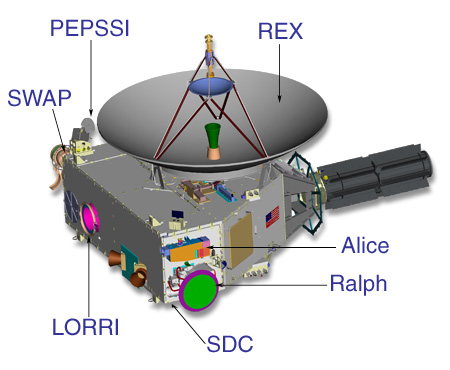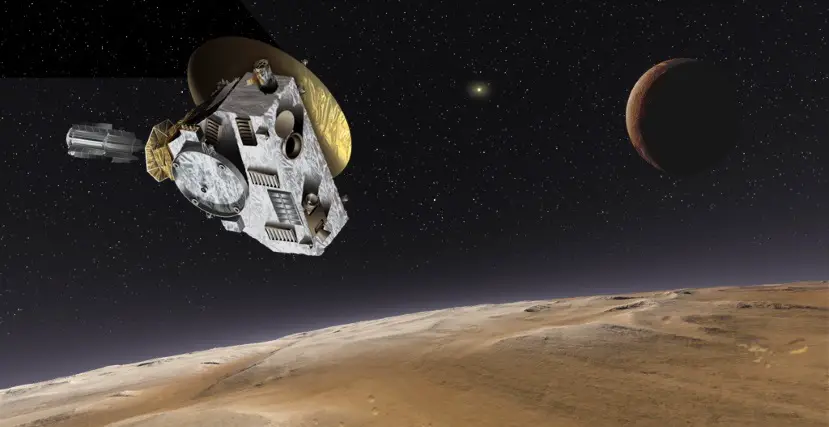It’s been a big week in space, that’s for sure! We saw the first test launch of the Orion spacecraft last Friday, and only a few days later, NASA’s New Horizons probe has awaken from its final hibernation after nearly nine years travelling through space. Launched on January 19th, 2006, the New Horizons probe has traveled nearly three billion miles and is set to take the closest look yet at our Solar System’s “Most Likely to Suffer an Identity Crisis” – Pluto and its moons.
When the New Horizons probe was launched, Pluto was the 9th planet in our Solar System. Only a few months later it was demoted to “Dwarf Planet,” but it’s still a celestial body that we’ve not seen up close. In fact, the best we’ve seen so far are images from the Hubble Telescope, which still only provided a blurry view of a “circular, reddish” planet. That will all change in about a month when New Horizons finishes its trip and starts doing Science. Starting on January 15th, New Horizons will begin its designated mission – observing Pluto and its five moons.

New Horizons has a bevy of instruments and cameras (many of which have conveniently easy to remember names) that will take our closest look yet at Pluto and its moons. Space Flight Insider takes a much closer look at what each of these instruments will do:
The actual mission, observation of Pluto and its five moons, will begin on January 15. The first images of Pluto surpassing those taken by the Hubble Space Telescope will taken in late April or early May. AP1 technically starts on Jan. 6 and lasts until April 4. During this phase, the spacecraft’s Long Range Reconnaissance Imager (LORRI), a telescopic camera designed for long range observation, will begin imaging Pluto and its moons.
Two other instruments, the Solar Wind at Pluto (SWAP), and the Pluto Energetic Particle Spectrometer Science Investigation (PEPPSI), will measure plasma. A solar wind and plasma spectrometer, SWAP is designed to measure the escape rate of Pluto’s atmosphere and the planet’s interaction with the solar wind. PEPPSI is an energetic particle spectrometer. It will measure both the density and composition of plasma ions escaping from Pluto’s atmosphere.
The Linear Etalon Imaging Spectral Array (LEISA), an infrared imaging spectrometer and sub-instrument of Ralph, which Stern describes as the “mission’s main sense of sight,” will study Pluto’s atmosphere in the infrared.
Alice, Ralph’s other sub-instrument, the ultra-violet spectrometer, will concurrently study Pluto’s atmosphere in the ultra-violet. Both will search the Plutonian atmosphere for winds, clouds, and hazes. Meanwhile, SWAP and PEPPSI will look for ions and bow shock.
Needless to say, we should learn more about Pluto and its moons in the coming months than we’ve ever known. Quite an exciting time in space, that’s for sure!
The video below goes into some detail about the sorts of things that NASA hopes to see (and provided the “circular, reddish” reference from earlier in this article). It was created just over a year ago, and it will be very interesting to see how New Horizons pans out, and what we can learn from our smallest stellar neighbor. Be sure to check out the source links for a much deeper look into the science of this mission.
[button link=”http://www.spaceflightinsider.com/missions/solar-system/new-horizons-awakens-final-hibernation/” icon=”fa-external-link” side=”left” target=”blank” color=”285b5e” textcolor=”ffffff”]Source: Space Flight Insider[/button][button link=”http://science.nasa.gov/science-news/science-at-nasa/2014/07dec_plutosdoorstep/” icon=”fa-external-link” side=”left” target=”blank” color=”285b5e” textcolor=”ffffff”]Source: NASA[/button]Last Updated on November 27, 2018.











Comments are closed.